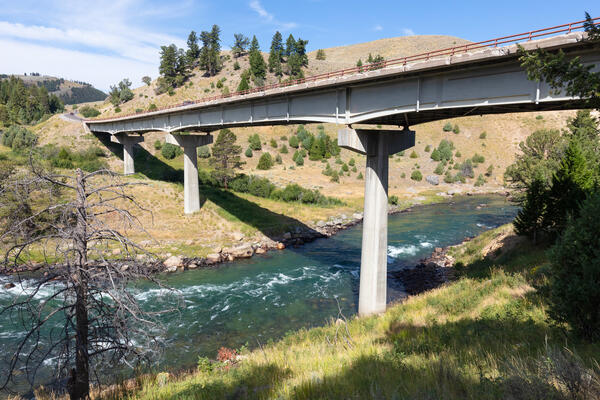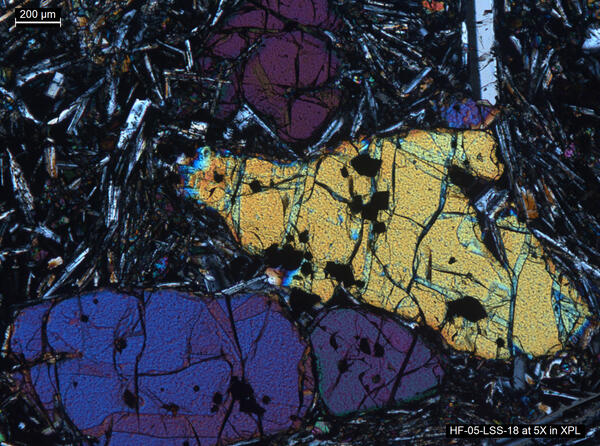An unconformity at the top of Mount Everts is located where the Huckleberry Ridge Tuff, 2.1 million years old, lies directly on top of Cretaceous sediments that are ~60 million years old and greater. Right at the unconformity are conspicuous orange and black colors. The orange is oxidation of the sedimentary unit where it is in contact with the ash, whic
Images
Images of Yellowstone.

An unconformity at the top of Mount Everts is located where the Huckleberry Ridge Tuff, 2.1 million years old, lies directly on top of Cretaceous sediments that are ~60 million years old and greater. Right at the unconformity are conspicuous orange and black colors. The orange is oxidation of the sedimentary unit where it is in contact with the ash, whic

A few miles south of Mammoth Hot Springs in Yellowstone National Park, Highway 89 winds through the white/gray jumble of rocks known as the Hoodoos, or Silver Gate, that formed when travertine from Terrace Mountain collapsed in a landslide.
A few miles south of Mammoth Hot Springs in Yellowstone National Park, Highway 89 winds through the white/gray jumble of rocks known as the Hoodoos, or Silver Gate, that formed when travertine from Terrace Mountain collapsed in a landslide.

Silver Gate landslide complex in Yellowstone National Park. The jumbled nature of the calcium-carbonate rocks is evidence that the deposit was formed by collapse of a travertine hot-spring terrace that might once have looked like Mammoth Hot Springs does today.
Silver Gate landslide complex in Yellowstone National Park. The jumbled nature of the calcium-carbonate rocks is evidence that the deposit was formed by collapse of a travertine hot-spring terrace that might once have looked like Mammoth Hot Springs does today.

Panoramic photo of Pocket Basin, a hydrothermal explosion crater in Yellowstone National Park's Lower Geyser Basin, taken from the northeast rim looking southwest into the crater. Pocket Basin is a U-shaped crater that is dissected on the SW edge by the Firehole River, visible on the far-right of the photo.
Panoramic photo of Pocket Basin, a hydrothermal explosion crater in Yellowstone National Park's Lower Geyser Basin, taken from the northeast rim looking southwest into the crater. Pocket Basin is a U-shaped crater that is dissected on the SW edge by the Firehole River, visible on the far-right of the photo.

The inside of a borehole seismometer equipment enclosure is full of batteries, cables, data communications equipment and data recording instruments. Some of the geodetic infrastructure in Yellowstone National Park is colocated with seismic equipment. In this case, the communications downlink radio for the GNSS station is housed with the borehole enc
The inside of a borehole seismometer equipment enclosure is full of batteries, cables, data communications equipment and data recording instruments. Some of the geodetic infrastructure in Yellowstone National Park is colocated with seismic equipment. In this case, the communications downlink radio for the GNSS station is housed with the borehole enc

GNSS site LKWY, which was visited in September 2020 to install new GNSS equipment and upgrade the communications for improved data quality. The site is now capable of collecting several times more observation data then was possible with the original older equipment.
GNSS site LKWY, which was visited in September 2020 to install new GNSS equipment and upgrade the communications for improved data quality. The site is now capable of collecting several times more observation data then was possible with the original older equipment.

View of Absaroka Range from Eagle Peak, WY, toward the southwest.
View of Absaroka Range from Eagle Peak, WY, toward the southwest.

The Upper Geyser Basin viewed from the Old Faithful webcam. Hot water was piped from Solitary Geyser to the former site of the geyser bathhouse.
The Upper Geyser Basin viewed from the Old Faithful webcam. Hot water was piped from Solitary Geyser to the former site of the geyser bathhouse.

Map of thermal areas in Yellowstone (red), as well as lakes (outlined in blue), many of which have thermal areas on their shores or beneath their surfaces.
Map of thermal areas in Yellowstone (red), as well as lakes (outlined in blue), many of which have thermal areas on their shores or beneath their surfaces.

High-resolution images of Fern Lake from different seasons. North is up. Fern Lake is about 1 km across from east to west. Red arrows in the winter image point to large zones of open water, indicating either nearshore springs or underwater hydrothermal vents, but there are also many smaller zones of open water that are conspicuous.
High-resolution images of Fern Lake from different seasons. North is up. Fern Lake is about 1 km across from east to west. Red arrows in the winter image point to large zones of open water, indicating either nearshore springs or underwater hydrothermal vents, but there are also many smaller zones of open water that are conspicuous.

Shaded relief map based on high-resolution topographic data from lidar and showing subtle terraces on the north side of Yellowstone Lake (a few example terraces are marked by yellow arrows and traced by dashed and dotted white lines).
Shaded relief map based on high-resolution topographic data from lidar and showing subtle terraces on the north side of Yellowstone Lake (a few example terraces are marked by yellow arrows and traced by dashed and dotted white lines).

The UNAVCO-operated geodetic infrastructure located in Yellowstone National Park consists of over a dozen continuously operating geodetic sites. Most of these sites stream real-time data to the UNAVCO data center. After the September 2020 maintenance trip, there are now 8 fully upgraded GNSS sites (red square) located in the park.
The UNAVCO-operated geodetic infrastructure located in Yellowstone National Park consists of over a dozen continuously operating geodetic sites. Most of these sites stream real-time data to the UNAVCO data center. After the September 2020 maintenance trip, there are now 8 fully upgraded GNSS sites (red square) located in the park.
Thin section made by slicing a small layer off the surface of a hand sample of Yeloowstone lava. Note the marker for scale.
Thin section made by slicing a small layer off the surface of a hand sample of Yeloowstone lava. Note the marker for scale.

An example of a boundary iproblem n the Yellowstone National Park geologic map, which was stitched together from many smaller mapped sections. The red line highlights the contacts that contain different units across the boundary.
An example of a boundary iproblem n the Yellowstone National Park geologic map, which was stitched together from many smaller mapped sections. The red line highlights the contacts that contain different units across the boundary.
Giantess Geyser in eruption at approximately 10:00 AM MDT on August 26, 2020. Old Faithful is erupting in the center background.
Giantess Geyser in eruption at approximately 10:00 AM MDT on August 26, 2020. Old Faithful is erupting in the center background.

A scanned image of Rocky Mountain juniper deadwood sample GGR100 collected in the northern part of Yellowstone National Park under permit YELL-5582. The full length of this sample covers the time period 723-1792 CE.
A scanned image of Rocky Mountain juniper deadwood sample GGR100 collected in the northern part of Yellowstone National Park under permit YELL-5582. The full length of this sample covers the time period 723-1792 CE.

The current bridge across the Yellowstone River near Tower Junction. The bridge was constructed in the early 1960s and has structural problems that require it to be replaced. The bridge will be removed once the new Yellowstone River Bridge is completed (scheduled for 2026). Photo by Jacob Frank (Yellowstone National Park) on August 17, 2020.
The current bridge across the Yellowstone River near Tower Junction. The bridge was constructed in the early 1960s and has structural problems that require it to be replaced. The bridge will be removed once the new Yellowstone River Bridge is completed (scheduled for 2026). Photo by Jacob Frank (Yellowstone National Park) on August 17, 2020.

Photo looking north from the north shore of Yellowstone Lake. The photo was taken from a level bench, or terrace, which marks a previous high stand of the lake. In the middle distance (between the two red lines), the ground slopes up to second, higher-level terrace that indicates an even higher past lake level.
Photo looking north from the north shore of Yellowstone Lake. The photo was taken from a level bench, or terrace, which marks a previous high stand of the lake. In the middle distance (between the two red lines), the ground slopes up to second, higher-level terrace that indicates an even higher past lake level.

USGS scientist Laura Clor performing maintenance on the SNIF multi-GAS station on Mount St. Helens, Washington.
USGS scientist Laura Clor performing maintenance on the SNIF multi-GAS station on Mount St. Helens, Washington.

Interior of the SNIF multi-GAS enclosure on Mount St. Helens, Washington
Interior of the SNIF multi-GAS enclosure on Mount St. Helens, Washington

Thin section image of a lava sample from Yellowstone using a polarizing microscope. The mineral assemblage is representative of many of Yellowstone’s basaltic rocks. The three large and colored crystals (known as phenocrysts) in the center of the image are the mineral olivine.
Thin section image of a lava sample from Yellowstone using a polarizing microscope. The mineral assemblage is representative of many of Yellowstone’s basaltic rocks. The three large and colored crystals (known as phenocrysts) in the center of the image are the mineral olivine.



